Welcome back to Indie February here at The Unspoken Decade! If you missed Dean Compton’s great look at Exiles in Part 1, I suppose you’ll just have something to look forward to once you’re done with this, Part 2, which delves into Topps Comics’ Satan’s Six! This comic is part of the Kirbyverse, made up of multiple titles released simultaneously that develop unrealized designs and concepts of the King himself, Jack Kirby. Darry Weight’s look at the whole of the Kirbyverse is coming up next in Indie February, so hopefully this glance in will whet your appetite for the whole enchilada!
Of course, that endeavor would probably be more likely if I had more positive things to say about Satan’s Six…
Before any fans of this work go reaching for their torches and pitchforks, as thematically appropriate as it might be for this comic, I should make the disclaimer that I won’t be wholly critical. There’s a lot of fun to be had reading Satan’s Six, and it injects a lot of humor into a traditionally horror setting. It’s got a great premise. All of the good so far, sure, but even from the first few pages, I would swear Satan’s Six is actively trying to get me to dislike it. For example, the word I kept coming back to in describing the art is abrasive:

The color palette is loud and garish, proportions distorted and grotesque. Much of the action is so heavily stylized that I can barely tell what is depicted in multiple panels. I’m sure some of the off-putting effect is intentional to reinforce the hellish subject matter, but the comic is so, well, just unpleasant to look at that I spent most of my time reading it going, “Gaaaaah” in my head.
My impulse to make that noise is helped not at all by the fact that of the three or four facial expressions characters make in this comic, one of them looks exactly like they are making that noise too. Seriously, this face:
The whole comic, however, does not look like this. Several pages were drawn by Kirby himself, which would be great (both because well, it’s Jack Kirby, and because they’re the only pages that don’t feel like the top layer of my eyes are being scrubbed off) if it weren’t for how awkwardly they are shoehorned in: the narrator basically just says not to mind the style change, this being hell and all.
This is not the only instance where the comic suffers from what I can’t decide is either lazy writing or attempts to be more clever than it actually is. The narrator herself, a Guardian Angel First Class of the Comic Book Division, is problematic in this vein, but before I get too deeply into those shortcomings I should probably, you know, say what the comic is about. I will kill two birds with one stone by showing some of Kirby’s work on the project and getting the premise across:
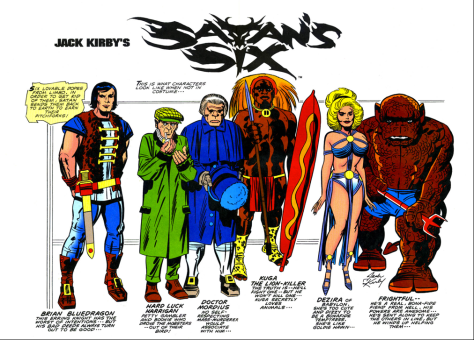
Pretty great premise, right? Being raised in a Pentecostal church, a denomination big on the fire and brimstone, I have always been fascinated by depictions of Hell and demons and different takes on the afterlife in general. The idea of a group of people trying to make it out of Limbo by winning souls for Hell is a great twist (made doubly great by them constantly messing up because they’re not evil enough), and the comic works best when it hews closest to this simple but brilliant idea. Where it starts to lose me is when they reach for the heavens.
I told you that the narrator, Pristine, is a guardian angel from the Comic Book Division, but what I can’t tell you is what purpose it actually serves to make her so meta, unless it is to highlight the gimmicky nature of the comic. She could just as easily be the guardian angel to these characters without explicitly telling you they are comic book characters, and I kept waiting for this breaking of the fourth wall to have a greater payoff than, say, allowing writer Tony Isabella to use the first six pages of Issue #2 to recap Issue #1 through Pristine.

None of this criticism is to say that the character doesn’t work at all. When the winking at the reader is toned down and she is merely meddling with our anti-anti-heroes’ plans, she is quite entertaining. For instance, while the Six are assisting a professor who has sold his soul to stop an ancient archaeological find of his from breaking free and taking over the world, Pristine reminds Frightful that if any of the Six should die saving someone, they’d likely go to Heaven, forcing him to intervene. There’s something sinister behind her wide grin, the inversion of the angelic and demonic does its best to add back a satisfying layer of complexity that the meta-ness subtracts.

The rest of the characters would have benefited greatly from a longer run, since they are thoroughly one-note in their introduction, but that doesn’t stop Satan’s Six from having some legitimately emotionally affecting moments. The third issue centers on one of Dezira’s old flames, everyone’s favorite hunchback Quasimodo, cutting loose from Limbo to save her from the Devil’s trickery. His own penance was almost up, and his act of self-sacrifice earns him an automatic ticket to Heaven, a sweet ending in a place I didn’t expect.
Of course, that sweetness is somewhat tempered by other weirdness going on in this issue, including a plot in which Quasimodo becomes a movie star after running into Lloyd Kaufman from Troma Entertainment. It’s a completely random-feeling and wonderful cameo, and the story gets in some nice satire of Hollywood, but like a lot of things in this comic, its many disparate elements feel like they were tossed in a blender, mixed up, and thrown at the wall to see what stuck rather than carefully thought out. There’s a haphazard feel to these proceedings that sometimes work and sometimes don’t but always make me feel frantic.
Just to further illustrate how many inconsistent parts make up this Frankenstein’s monster of a comic, I’ll mention, but not go into any great detail about an unfortunate incident involving Dr. Mordius drinking a potion of his own concocting and turning into a dog. On its own, that transformation wouldn’t be so bad, but the “what the fuck?” quotient is upped when he is chased around by another, amorous dog. Yeah, that’s all I’ve got to say about that…

How about we look at another page of Jack Kirby’s, just to cleanse the ol’ palate?

The fourth and final issue in its initial run also tells a pretty emotionally satisfying story in which Harrigan schemes to negate a former colleague in crime’s contract with the Devil, but once again, the sweetness is undercut by a pretty silly gimmick. This time it’s another cameo, one that could actually make more sense, given the hellish backdrop of the story, but is somehow integrated worse into the story than freakin’ Lloyd Kaufman.
 The gist is that Odious Kamodious, the demon who made the deal to send the Six back to Earth, is unhappy with Freightful’s performance as Team Leader and threatens to replace him with Jason Vorhees. Everyone fights for a bit and then Odious sends Jason back to Hell, but not before hanging a lampshade on the gimmick. Once again, I don’t know if this is supposed to be clever, but it just feels half assed. They could have legitimately inserted Jason into a story a million better ways, which I know to be true because one of Dean’s favorite things to do is talk about Jason showing up to machete irritating people, and it’s always more entertaining than this diversion.
The gist is that Odious Kamodious, the demon who made the deal to send the Six back to Earth, is unhappy with Freightful’s performance as Team Leader and threatens to replace him with Jason Vorhees. Everyone fights for a bit and then Odious sends Jason back to Hell, but not before hanging a lampshade on the gimmick. Once again, I don’t know if this is supposed to be clever, but it just feels half assed. They could have legitimately inserted Jason into a story a million better ways, which I know to be true because one of Dean’s favorite things to do is talk about Jason showing up to machete irritating people, and it’s always more entertaining than this diversion.

I feel like I’ve spent a lot of time criticizing Satan’s Six, but the more I’ve written about it and read sections of it again, the more I actually like. It’s worth reading for its premise and humor alone, and given more time, I think it would have suffered less from its gimmicks, since the non-gimmicky stuff seems so outweighed in only four issues. It’s frustrating to read something that doesn’t live up to its potential, but its flaws make it almost more intriguing than if it were just good, which is probably why I took up so much space discussing them. I can honestly say I’ve never read anything like Satan’s Six, and sometimes that’s the most ringing endorsement I can give.
Something else I enjoyed about this comic were the mini comics that closed out each issue, my favorite being one from Wolff and Byrd, Counselors of the Macabre. (Such a great name.) Wolff and Byrd turn up again in the main story of Issue #4, and at the end of Issue #1 they defend a demon summoned and abused by a professor. I’ll leave you with one of my favorite context-less panels ever and remind you one more time to be sure to come back for more of the Kirbyverse as Indie month continues!


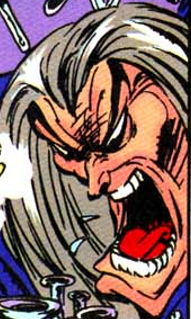
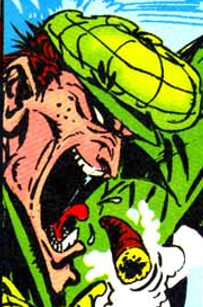
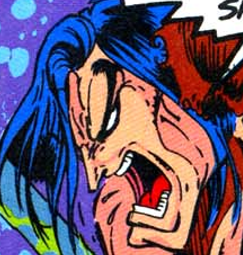
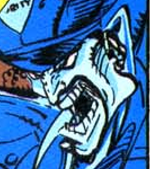
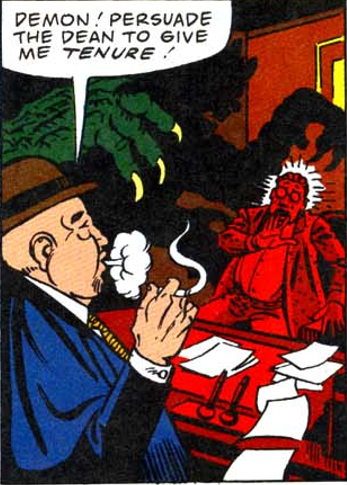
Kirby’s creations on Topps suffered from the 90’s hype. They want Kirby because well he’s Kirby but they want to get a ride on the “Image Comics” Style from the 90s, that was very new at time but looking in retrospect was horrible. Even Image’s creators like Erik Larsen today are more “Kirby” and regret that style from the 90s.
LikeLike